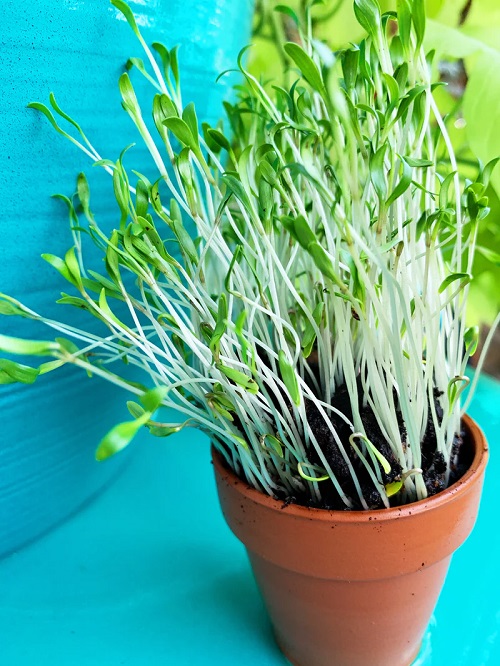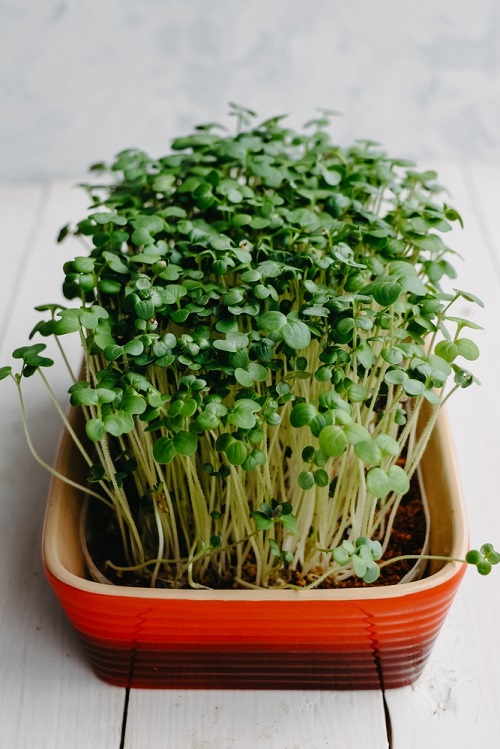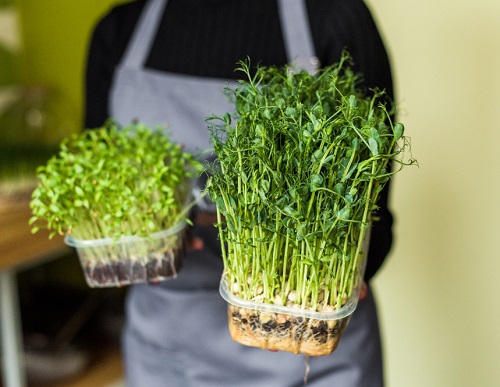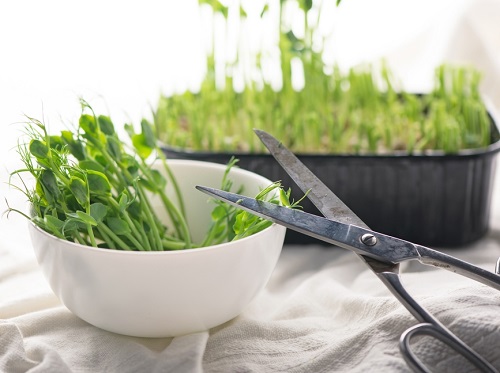Micro Cilantro – a powerhouse of health and taste that you must add to your salads and daily diets! Here’s how to grow it!
Micro Cilantro – Often overlooked but incredibly potent, this tiny powerhouse brings all the pungent flavors of traditional cilantro in a miniaturized, nutrient-packed form. Perfect for gourmet kitchens and amateur food enthusiasts alike, this is a game-changer!
Check out Different Types of Cilantro and Coriander here
What is Micro Cilantro
Micro cilantro is the young, tender version of the well-known herb cilantro (Coriandrum sativum). Harvested just after the first true leaves (cotyledons) have developed, this miniature version offers an intense, concentrated flavor compared to its fully-grown counterpart. Let’s delve into its origin, taste, and culinary applications.
Micro cilantro is packed with nutrients like Vitamin K, Vitamin C, and various antioxidants. It shares similar health benefits to mature cilantro but in a more concentrated form.
Find Cilantro in Different Languages here
Propagating Micro Cilantro
Methods to propagate Micro Cilantro:
- Direct Seeding
- Transplanting
- Hydroponic Cultivation
The easiest method: Direct Seeding
- Choose a well-draining planting container or garden bed with good-quality soil. Ensure the soil is loose and free of debris.
- Sprinkle micro cilantro seeds evenly over the soil surface. Gently press them down using a flat tool or your hand.
Spacing: Space the seeds about 1 inch apart to allow room for growth. - Lightly cover the seeds with a thin layer of soil, no more than 1/8 inch deep.
- Water the seeded area gently to moisten the soil. Ensure the soil stays consistently moist but not waterlogged.
- Place the container or bed in a sunny location with at least 4-6 hours of sunlight per day. If growing indoors, provide a source of bright, indirect light.
- Micro cilantro seeds typically germinate in 7-14 days.
- Once the seedlings have grown to about 1-2 inches tall, thin them out, leaving the strongest plants spaced about 2 inches apart.
- Continue to water as needed to keep the soil consistently moist. Micro cilantro grows rapidly and can be ready for harvest in 14-21 days from seeding.
- Use scissors or shears to snip the micro cilantro leaves just above the soil line when they reach the desired size, typically around 1-2 inches tall.
Best Pot Size for Growing Micro Cilantro
For Micro Cilantro, you can use any shallow dish that’s 2-4 inches deep and as much wide as possible to increase your harvest!
Find What to Do with Cilantro Flowers here
Requirements for Growing Micro Cilantro
Location
A sunny windowsill with at least 4-6 hours of indirect sunlight per day can suffice for growing micro cilantro. Rotate the pot/tray every other day to ensure even light distribution among the plants.
Soil
Micro Cilantro thrives in well-draining, loamy soil. Use this mix for the best growth:
- Coconut Coir or Peat Moss: 40%
- Vermiculite: 30%
- Perlite: 20%
- Worm Castings or Compost: 10%
Check Cilantro Companion Plants here
Water
Unlike mature plants, microgreens have a shallow root system and are grown in shallow trays, making them more susceptible to both overwatering and underwatering.
Use a fine mist spray bottle to moisten the growing medium whenever the top layer feels a little dry to the touch – which can be once in 1-2 days.
Temperature and Humidity
Micro Cilantro prefers a temperature range of 60-90°F (15-32°C) for optimal growth. Maintain moderate humidity levels around 40-60%.
Keep Micro Cilantro in a comfortable, well-ventilated environment to promote healthy development.
Micro Cilantro Care
Fertilizer
Generally, microgreens get enough nutrients from the seed and soil during the first week of growth. Additional fertilization at this stage is usually unnecessary. To boost the growth, however, you can go for a balanced liquid fertilizer. Do dilute it to 1/4 of its strength.
A single application is often sufficient for the short growth cycle of micro cilantro. Excessive fertilization can lead to overly rapid growth, diluting the flavor.
Pests and Diseases
Micro Cilantro is generally hardy but can still be susceptible to some pests and diseases. Common issues include:
1. Aphids: These small insects can suck the sap from cilantro leaves, causing curling and yellowing. Use insecticidal soap or neem oil to control them.
2. Whiteflies: Whiteflies can lead to a decline in cilantro health. Remove affected leaves and use yellow sticky traps to catch them.
3. Powdery Mildew: A fungal disease that appears as white, powdery spots on leaves. Ensure good air circulation, avoid overcrowding, and apply fungicidal sprays if needed.
4. Damping-off: This disease affects seedlings, causing them to wilt and die. Prevent it by using well-draining soil, not overwatering, and maintaining proper spacing between plants.
5. Cilantro Rust: It manifests as orange or brown rust-like spots on leaves. Remove affected foliage and apply fungicides if necessary.
6. Root Rot: Overwatering or poorly draining soil can lead to root rot. Improve drainage and avoid overwatering to prevent this issue.
Harvesting Micro Cilantro
Timing for Harvest
- Days to Harvest: Generally, micro cilantro is ready for harvest 14 to 21 days after seeding, depending on growing conditions.
- Signs of Readiness: Look for the first set of true leaves, also known as cotyledons, to be fully developed. The plants should be about 2-3 inches in height.
- Flavor Test: Conduct a taste test to make sure the leaves have developed the flavor profile you desire.
Learn How to Grow Cilantro in a Pot here
Steps:
- Gently hold a clump of micro cilantro leaves, and snip them using the scissors. Try to cut just above the soil line.
- Do not disturb the roots or soil. This minimizes the chance of mold and bacteria growth.
- Harvest the micro cilantro in sections if you don’t need the entire tray at once. This way, the remaining plants continue to grow and can be harvested later.
- Micro cilantro is best used immediately after harvesting for optimal flavor and nutrition. However, it can be stored in the fridge for up to a week if needed.
Micro Cilantro Uses
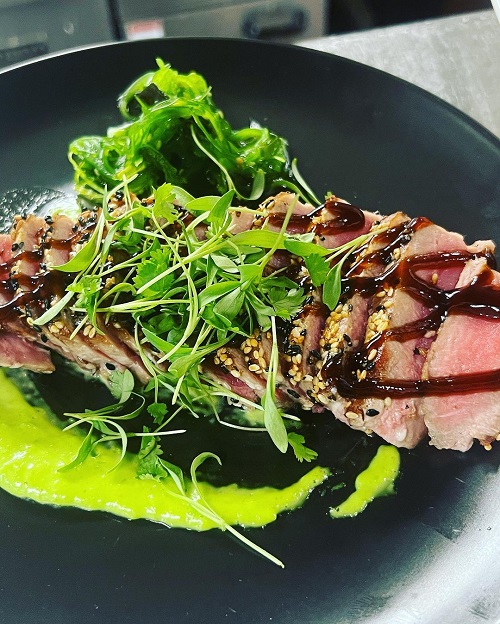
- Garnish: Micro cilantro is widely used as a garnish in various dishes, both for its aesthetic appeal and its robust flavor. Its small, delicate leaves add a burst of fresh, peppery, and citrusy notes to salads, soups, and main courses.
- Salads: Micro cilantro can be sprinkled on salads to enhance flavor. Its tender leaves complement greens, vegetables, and fruits, giving the salad a zesty and aromatic touch.
- Tacos and Mexican Dishes: Micro cilantro is a common topping for tacos, quesadillas, and other Mexican dishes. Its vibrant flavor pairs well with spicy salsas, guacamole, and grilled meats.
- Asian Cuisine: It’s a popular addition to Asian-inspired dishes like sushi, spring rolls, and stir-fries. The cilantro’s fresh and slightly tangy taste complements the flavors of soy sauce, ginger, and garlic.
- Soups and Stews: Micro cilantro can be used as a finishing touch for soups and stews, adding a burst of flavor when sprinkled on top just before serving.
- Sandwiches and Wraps: Elevate the taste of sandwiches, wraps, and burgers by incorporating micro cilantro. It adds a unique and refreshing flavor dimension.
- Seafood: Micro cilantro pairs exceptionally well with seafood, enhancing the taste of fish and shellfish dishes.
- Cocktails: Some mixologists use micro cilantro as a creative garnish for cocktails, especially those with herbal and citrusy notes.
Learn How to Grow Cilantro from Stem Cuttings of Grocery Store Bunch here
Micro Cilantro Taste
The taste of micro cilantro is robust and complex, encapsulating the essence of mature cilantro but with a more concentrated punch. Its flavor profile includes hints of citrus, pepper, and a touch of sweetness.
The intensity makes it an excellent choice for dishes where a powerful cilantro presence is desired.


